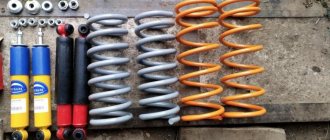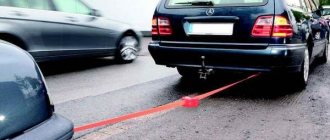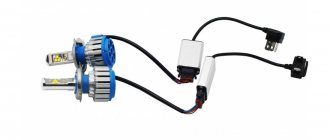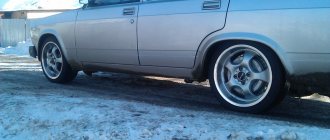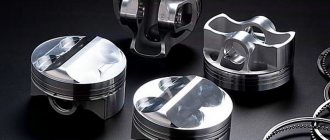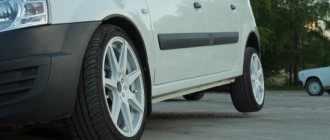Author: Evgeny Zhivoglyadov. Date of publication: February 16, 2016. Category: Automotive equipment.
There are many automotive elements for the safety of pedestrians and drivers, but today sound signals are “a step above” the same type of alarm sirens, seat belts and other things. Previously, horns could not boast of much variety, and on the road all cars sounded almost in unison; you could only choose the volume of the horn and nothing else. Today the situation has changed and you can stand out on the road not only with unusual airbrushing, tuning and sound, but also by installing a musical signal on your car or even a “locomotive whistle”. Fortunately, there are no prohibitions or GOSTs on the volume or sound of such devices yet, with the exception of “quacks” for which traffic police officers can severely punish. Yes, there is no law on the non-use of special signals, but there is an unspoken rule that all experienced motorists adhere to.
If we talk about the types of signals, there are many of them; we will consider only the main and most popular ones.
Car horn device
The term itself came into use thanks to a company that manufactured such devices at the beginning of the last century (Klaxon Signals Ltd).
Today, the word “horn” refers to both a technical device for issuing a sound signal and the signal itself. We will use the term exclusively in the first meaning. So, according to the method of producing sound, car horns are divided into three large categories:
- electromagnetic;
- pneumatic action;
- electronic.
We will look at the features, advantages and disadvantages of each variety a little later. Although the global and most important characteristic of these devices is the noise level, car audio signals differ both in sound tone and, naturally, in their design. In particular, it is customary to distinguish between tone and sound horns based on their sound, and horn/hornless horns based on their design. There is a clear relationship between these categories: tonal ES have a horn design, while audio ones, as a rule, have a hornless design.
The hornless noise horn consists of a steel body (1) with a membrane and an electromagnet inside. The electromagnet includes a yoke (2), an armature (4), a magnet core (5), and a coil (3). Closer to the outer part of the horn (between the body and the cover (9)) there is a membrane rigidly connected to the electromagnet armature.
Behind the membrane there is a resonator that enhances the level of noise emitted by the horn and also regulates the tone of the sound. The electromagnet is powered through the breaker contact group (7).
The thickness of the membrane also affects the tonality of the sound: the thicker it is, the lower the tonality.
A tone horn horn consists of a body (1), an electromagnet, a membrane (6), a cover (8) and a horn body (7). The electromagnet, as in the first case, includes an armature (3), a core (2) and a yoke (5). Thus, in principle its design is not much different from its noise analogue, but the fundamental difference is the absence of a resonator. Its role is assigned to the air column formed in the horn. The configuration of the horn is such that, due to a change in the vibration frequency of the membrane, the level of the air column also changes. The latter is precisely responsible for obtaining a certain tone of the horn sound. The end of the horn is made in the form of an expanding bell like a horn, which is why it is sometimes called that.
To minimize the sparking inherent in the operation of the chopper, in both types of audio signals additional capacitors or resistors are included in the circuit. In budget devices, the installation of means that reduce sparking is not carried out.
Electronic signals
Strictly speaking, horns that operate under the control of an electronic chip are considered a separate type of car horn. But here the electronics are also a sound generator (instead of an oscillating diaphragm), and an electrodynamic loudspeaker plays an important role, amplifying the signal. Its peak power is 110 dB, but the frequency range can vary significantly from model to model.
Electronic horns are the most compact; there are usually no problems with their installation; they can operate on a 12 or 24 V mains voltage and reproduce single-tone sounds or polyphonic sounds, including melodies.
Please note that you should not get too carried away with giving non-standard signals: they are allowed only in cases where this is required to prevent an accident. It is prohibited to sound signals within the coverage area of the corresponding road sign (3.26). The traffic police officer will definitely not like the sound of the horn, which resembles a special signal - in this case, you will probably get into trouble.
Please note that the fine for such violations is standard – 500 rubles.
The working principle of a car horn
Like the design diagram of horn and hornless sound signals, their operating principle is largely similar. The main actuator in both cases is an electromagnet. Power is supplied to the coil through the breaker contact group. The sound source is a membrane rigidly connected to the armature of the electromagnet. When you press the signal button, a current is supplied to the magnet, which sets the armature in motion - being attracted to the core, it affects the membrane, which begins to bend.
This is a cyclic process: as the armature moves, the contacts of the breaker begin to open, the membrane, trying to return to its previous position, puts pressure on the armature, which also returns to its normal place. It is the vibrations of the membrane that form the sound, the tonality of which depends on the frequency of the horn.
Cars usually use a parallel circuit for generating low/high pitch signals, which as a result overlap each other quite harmoniously, generating a multi-tone audio signal. As a rule, in absolute value the difference between high/low frequency signals does not exceed 70-100 Hz.
In addition to frequency and sound level, a car signal is characterized by such parameters as spectral composition and sound pressure level (a value measured in decibels). Transport noise is best covered by sound whose frequency spectrum is in the range of 1800-3500 Hz. All parts of a car horn are oriented towards these values, from the membrane to the resonator, as well as their shape, configuration and materials of manufacture.
LandCruiser Tuning › Blog › Mega-powerful sound signals
We recently received 3 options for alternative sound signals.
They are probably the most powerful we have ever had, so be careful when watching the video))) So, the first new product...
Signals Maruko Horn Supergiga
A similar horn is standardly installed on Lexus cars.
Operating voltage
- 12V
Current consumption
- 4A X 2
Sound pressure level
- 113dB
Frequency
- Hi: 500Hz, Low: 400Hz
Weight
/180g X 2
Size
/ mm 75 X D68mm
Manufacture
: Japan
Price:
4500 rub.
Signals MITSUBA MBW-2E23R
The mid-frequency sound signal of the MITSUBA MBW-2E23R is the loudest signal among its kind. It is also very interesting in that it works in two modes: a standard abrupt sound and a “bell” type sound signal (slow decay of sound). This sound is achieved thanks to the very complex and expensive “piezo sound” technology, on the basis of which this model of car signals was developed. In addition, the signal on the car was made in Japan, which indicates its reliability. The kit includes two MBW-2E23R signals and a unit with a built-in microprocessor.
Also, we can supplement these signals with a button (for switching modes) under the standard plug.
Sound options
: normal and fading bell sound
Mid-frequency
signal tone Operating voltage
12V
Current consumption
4Ax2
Sound volume
(2m from source) 113dB
Signal frequency
Hi:480Hz / Lo:400Hz
Unit dimensions
63.0×71.5×33.8 (mm)
Overall dimensions
95.0×99.5×64.0 (mm)
Manufacture
: Japan
Price
: 12,500 rub.
Well, the third option...
Signals MITSUBA SW-53
The Mitsuba SW-53 sound signal is the most powerful signal in the line of the famous Japanese manufacturer Mitsuba. This model with a bass sound volume of as much as 114 dB is an excellent replacement for the traditional “quiet” horn. The SW-53 is impressive in both volume and size. In addition, this car signal is very interesting because it works in two modes: a standard abrupt sound and a “bell” type sound signal (slow sound decay). This sound is achieved thanks to the very complex and expensive “piezo sound” technology, on the basis of which this model was developed. And the fact that the signal on the SW-53 car was made in Japan indicates its 100% reliability. The kit includes two SW-53 signals and a unit with a built-in microprocessor.
Sound options
normal and the sound of a fading bell
Signal tone
is low-frequency
Operating voltage
12V
Current consumption
4Ax2
Sound volume
114dB
Signal frequency
Hi:390Hz / Lo:320Hz
Unit dimensions
63.0×71.5×33.8 (mm)
Overall dimensions
152.0×137.0×98.0 (mm)
Made in
Japan
Price:
25,000 rub.
Source
Electromagnetic horns
It is this type of sound signals for cars that has become most widespread, largely due to the simplicity of the design and attractive cost. As we have already said, the main components of such devices are a pair of diaphragm - solenoid (electromagnet). According to their design, electromagnetic horns are divided into three subcategories:
- a snail that is relatively large in size due to its funnel-shaped geometry. For horns of this type, the maximum beep power level is about 120 dB - this is enough to effectively influence pedestrians and vehicle drivers. Due to its large dimensions, the snail is not easy to mount, and on many modern cars it is completely impossible to find a place for them in the engine compartment;
- The disc horn is the most compact in its class, providing a monophonic sound with a frequency of 350-400 Hz and a power of up to 115 dB. Due to its small size, it can be installed both in the engine compartment and outside (for example, on the radiator grille). There are disk devices of collapsible and non-dismountable designs;
- The horn horn resembles a pioneer horn in appearance, but structurally it is the same snail, but straightened and with a bell. Most often, such a signal is mounted outside the car; when located in the engine compartment, the sound volume is noticeably reduced.
Features of horn installation
When purchasing a car signal, you will probably find instructions for self-installation in the box, but you should understand that you should undertake such work only if you are sure that you are doing everything correctly. If there is no such confidence, then it is better to entrust the installation of an electric sound signal on a car to a specialist.
If the type of the new horn matches the type of the standard one, there should be no problems: just dismantle the old device and install a new one in its place. If the dimensions do not match, you will have to look for another place and tinker with the fastening. The most difficulties arise when installing pneumatic signal devices. Here, in addition to the horn itself, it will be necessary to install a powerful compressor, the dimensions of which cannot be compact.
In addition, the pneumatic horn compressor will consume a lot of energy, so you should make sure that the parameters of the generator and battery can ensure its operation without damaging the on-board electrical network.
Pneumatic horns
In horns of this type, the generator of sound signals is the same oscillating membrane, but it is driven not by an electromagnet, but by compressed air. The horn is designed to greatly amplify the sound of the signal.
If you want the sound of your car horn to scare away birds at a distance of up to half a meter and don’t know what type of horn to install on your car, feel free to choose a pneumatic one. It provides sound at a level of 145-150 dB.
Such powerful horns can structurally consist of four tubes, and to generate diaphragm oscillations with a frequency of 400-800 Hz, compressors capable of pumping up a pressure of at least 60 atmospheres are used.
The presence of several tubes provides the possibility of multi-tone sound, and even playback of simple melodies. Of course, the dimensions of such a sound device cannot be small, and to reproduce multi-tone sound, microprocessor controllers are used to control the operation of the compressor and other actuators.
Installation of a pneumatic sound signal on a VAZ 2107
Some car owners install a powerful pneumatic sound signal on the VAZ 2107. Installation of such a device is quite simple. You will need a grinder, a drill and a standard set of plumbing tools.
Universal pneumatic horn model fits most cars
First you need to determine where the horn and compressor will be located, and then make brackets to mount them. Typically, the pneumatic signal is installed behind a decorative grille in front of the radiator.
The pneumatic signal is usually placed in front of the cooling radiator
Installation is carried out in the following order:
- We make brackets from a suitable material (metal corner or strip).
- We install the brackets on the top panel in front of the cooling radiator in accordance with the dimensions of the pneumatic claxon and the design of its fastenings.
The manufactured brackets are screwed into places suitable for attaching the pneumoklaxon - We install the pneumoklaxon on the brackets.
- We mount the compressor on the standard signal brackets or on the panel near the radiator.
The air compressor is installed next to the cooling radiator - We connect the horn and the compressor with a hose from the pneumatic signal kit.
- We connect power to the pneumoklaxon from the standard AP.
If the current consumed by the compressor is more than 5 A, according to the scheme described above, you will need to install an additional relay to be on the safe side.
A pneumatic horn is impractical because it is equipped with a compressor that has a delay in starting. The compressor is short-lived and may quickly require replacement; moreover, in severe frosts, the compressor may fail and the signal will not sound.
In practice, the installation algorithm for a pneumoklaxon is determined by its size, type, design of fastenings, etc.
Best Pneumatic Car Horns
GAZ kit 22-221-3721010, HQ-302 / HQ-303
This model has good volume and power. The case has good strength and an excellent combination of quality and cost. It is connected using one positive terminal, which must be taken into account when reinstalling it on another vehicle. Checking and adjustment are carried out in the factory. To ensure that the sound quality does not disappear and the warranty remains, you need to maintain the integrity of the adjusting screw with the seal. And in order for the product to serve for a long time, it should be protected from moisture and chemical reagents.
Price - 864 rubles.
GAZ kit 22-221-3721010, HQ-302 / HQ-303
Advantages:
- volume;
- good combination of cost and quality;
- hull strength.
Flaws:
- not found.
Pennant SA-01 (in 2 tones, snail, noise level 118 dB)
With the help of this device, drivers prevent emergency situations. Many are content with the factory signal, but some drivers prefer the original sound. But some people just need power.
This device has an attractive design, good sound volume, and a long service life, as high-quality materials were chosen during production. The owner of such a device is pleased with the assembly.
Costs 450 rubles.
Pennant SA-01 (2 tones, snail, noise level 118 dB
Advantages:
- will last a long time;
- interesting appearance;
- loud sound;
- high quality of raw materials and workmanship.
Flaws:
- not found.
Skyway S07061008
This model of pneumatic sound signal is shaped like a horn. With its help, the car will be able to emit a fairly loud warning horn while driving or when parking, which will help avoid a traffic accident. The sound of the signal will be reminiscent of the horn that was previously used in carriages or steam engines. "Skyway S07061008" can be installed as an additional vehicle tuning or as the main sound signal.
This model is universal, it can be installed on any vehicle. The noise level of "Skyway S07061008" is 120 dB, and the frequency range varies from 540 Hz to 680 Hz. The length of the horn is 45 cm, and the operating voltage is 12V. This horn also comes with a compressor and mounting kit.
The average cost is 1400 rubles.
Skyway S07061008
Advantages:
- Loud noise;
- Low audio pitch;
- Suitable for cars and trucks;
- The kit includes a compressor and mounting kit.
Flaws:
- No relay to connect.
Airline AHR-24P-05
This model consists of two horns that will not only help change the standard vehicle horn, but will also become an original decoration for the car. To manufacture the Airline AHR-24P-05, the manufacturer used high-strength plastic and aluminum. It is worth noting that this model is universal; it can be installed on both cars and trucks.
The volume of the Airline AHR-24P-05 is 125 dB, and the beep frequency range varies from 370 to 415 Hz. To operate the device, you will need a 24V network. Therefore, although the model is considered universal, it is still more suitable for trucks.
The average cost is 1300 rubles.
Airline AHR-24P-05
Advantages:
- High volume;
- Low frequency range;
- Quality of materials;
- Two-tone sound.
Flaws:
- Not detected.
Airline AHR-12R-02
This model is a horn sound signal. With its help, you can easily attract the attention of other drivers or pedestrians, which will help avoid accidents. Since this horn requires a voltage of 12V to operate, it is better to use the Airline AHR-12R-02 in passenger cars. But still, this sound signal is universal; it can be installed on vehicles of domestic manufacturers and on cars of foreign companies. It is worth noting the compact size of the Airline AHR-12R-02, thanks to which the horn can be mounted in any part of the vehicle.
The set of this device consists of two signals, they have approximately the same frequency range, due to this the sound will have a high volume. This feature also makes the signal volumetric and increases its saturation. Therefore, other drivers will hear it despite high speed or loud music in the car.
The volume of the Airline AHR-12R-02 is 118 dB, and the frequency range varies from 410 to 510 Hz. To manufacture the Airline AHR-12R-02, the manufacturer used plastic and metal. Fastening elements are also included with the device.
The average cost is 650 rubles.
Airline AHR-12R-02
Advantages:
- Compact size;
- Easy installation;
- Loud and surround sound;
- Workmanship;
- Affordable price.
Flaws:
- Not detected.
Universal air signal 12/24 V, HQ 101
On special equipment used in road construction, on railways and in other places, a pneumatic air signal is used. These devices have a special design that allows them to produce powerful sound at high volume. Such a sound in an open space will be heard 1-2 km and further, and if it is presented at construction sites, it will be heard even when the machines are running. The use of such devices increases safety when working with special equipment and railway vehicles.
The high volume made these devices popular among truck drivers. The company has its own brand for the production of such horns. The products are ideally installed on any car. They can be used on trucks where the voltage reaches 24 V. They are also suitable for vehicles with a voltage of 12 V.
Costs 1000 rubles.
Universal air signal 12/24 V, HQ 101Advantages:
- loud noise;
- versatility;
- can be used for different types of equipment.
Types of devices
Choosing a car horn is not an easy task. Manufacturers offer a wide range of horns with a wide variety of alerts. The devices can make squeaking, howling, frightening and screaming sounds. When choosing, you need to take into account some nuances. After all, horns are produced in different shapes and sizes. When purchasing, you need to take these characteristics into account.
Klaxons are produced in the following types:
- pneumatic operating principle;
- electromagnetic devices;
- electronic devices.
Each type has its own characteristics. Models differ in the strength of the alert issued and the principle of operation. Some types have a number of subclasses.
Differences between pneumatic devices
Klaxons not only have different shapes and dimensions. Many have their own installation method. Pneumatic devices operate using a special technology. The compressor pumps compressed air into the pipe, which causes a vibration effect. The power of such signals reaches 125 decibels. Ranges typically range from 320 to 810 Hz. These indicators vary greatly for different models of pneumatic devices. In order for the car to produce a full signal, it is necessary to create a pressure of 6 atmospheres. In this case, the horn will produce the necessary cascade of melodies. However, it is necessary to have the necessary space under the hood and set the air horn.
Electromagnetic devices
Klaxons of this type also come in different types. One of the components is an electromagnet. It is connected to the membrane of the device. Next, a breaker is connected to the work, which is connected to the core winding. By pressing the button, the driver supplies electric current to the entire device. In this case, first of all, the core rod is activated, which produces vibrations. Vibration, in turn, sets the membrane in motion.
Electromagnetic devices differ in how they emit waves:
- Disc devices. Manufacturers make them in one-piece and collapsible types. The first option has smaller dimensions. The device has different designs. It can be installed under the hood and on the roof of the car. Manufacturers produce the device with single and double tone. It is easy to use and easy to install.
- Snail-shaped devices. These products are quite large in size. They are more difficult to install at your workplace. The product resembles a curved pipe, which is why it was nicknamed a gramophone. The device produces 118 decibels at a frequency of 510 Hz. The sound produced by such a horn has a strong impact on others. If you purchase a product with two tones, equipped with a relay, you can create an alert with a pleasant melody.
- Horn horns. The devices have a distinctive feature. They are made in the shape of a forge.
The installation of such systems has its own specifics. The product is mounted on the outside of the car. If the device is installed under the hood of a car, there is a significant decrease in the volume level.
Any type of device has its own shape and technical parameters. More accurate information can be found in the instructions or from the seller. A lot of interesting things are posted on websites and online stores.
Electronic products
A distinctive feature of the device is a chip that produces sound of the desired frequency. After this, it is converted on the loudspeaker. The power often reaches 110 decibels. However, it varies widely on different models.
The devices are powered by 24 or 12 V current. Users note its universal properties and ease of use. A wide range of models allows you to choose a product with any signal (from one tone to a variety of melodies).
Unusual solutions
Many drivers install locomotive horns on their cars. The product is able to attract the attention of others, because it has the necessary power. However, its installation will require a certain space under the hood of the iron horse.
Despite the loud sound, such a horn cannot be used in urban environments because the warning is too strong. The driver can be fined a hefty sum. In addition, the use of such a device requires high-quality noise insulation in the machine.
Premium segment
BOSCH 9320335206
This product can be installed on almost any vehicle.
This device has a good clear sound, which makes it possible to signal other road users. It can be used in different climatic conditions, including long trips with climate change. Resistant to high and low temperatures. At the same time, it retains its characteristics. The material used to make the socket is plastic. This model will serve as a driver's assistant.
The device costs 2300 rubles.
BOSCH 9320335206
Advantages:
- Universal design solution “snail”. This design is reliable, versatile, and easy to install, which are its main advantages.
- The device can be used at a voltage of 12V. Power supply from such a network makes it possible to use it in any passenger car or minibus.
- Has a good level of sound power. It will be clearly audible at a distance of 1-2 meters from the car.
- Produces sound using a membrane. Reproduced using an electromagnet.
Flaws:
- not found.
Hella 3FH 007 424-811
The history of the brand goes back 100 years, during which the company produced various accessories for cars of high quality. Products for car signals were among them; operation took place under different conditions. They are used to indicate turns, warn of danger and in other situations. This model is offered to the attention of car owners.
Used in cars with 12V voltage. This device produces a sound of good timbre and volume, the sound propagates over a decent distance. Devices of this type have a plastic case, characterized by compact dimensions, made in red and black colors. The housing is equipped with a Teflon seal for moisture protection. This model can be installed in two positions: vertically and horizontally. This makes using the product comfortable.
Costs 1700 rubles.
Hella 3FH 007 424-811
Advantages:
- good volume and power indicator provide safety to the driver and passengers of the car;
- plastic body;
- sound spreads over a large radius;
- anti-corrosion protection;
- attractive design solution in a sporty style;
- installation horizontally or vertically;
- presence of a moisture-proof Teflon seal.
Flaws:
- not found.
Horn problems
| Sound signals do not work | Debugg |
| a) The fuse has blown. | Replace the fuse, first eliminate the cause of the fuse blown. |
| b) Open circuit in the audio signal circuit: the tips of the wires in the detachable connections are oxidized or disconnected, the wires are damaged. | Check sequentially for the presence of a circuit in the detachable connections according to the diagram for switching on the sound signals |
| c) Oxidation, contamination of the contact ring on the steering wheel. | When the contact plate of the central switch is shorted to ground, the sound signals operate. Clean the slip ring and adjust. |
| d) The steering wheel fittings, the signal button lining are skewed, or the gap for turning on the sound signals is not adjusted. | When the contact plate of the central switch is shorted to ground, the sound signals operate. Clean the slip ring and adjust. Replace damaged parts, bend the steering wheel pad, adjust. |
| e) The horn switch plate of the central switch is bent or broken. | When the contact plate of the central switch is shorted to ground, the sound signals operate. Clean the slip ring and adjust. Bend the plate or replace the central switch. |
| e) The relay for turning on the sound signals does not work. | Check the relay for functionality, if damaged, replace it with a similar one. |
| g) The jumper is installed incorrectly at the installation location of the audio signal relay on the mounting block. | Check and install the jumper correctly: on the block. |
| i) Open circuit of the mounting block: burnt out tracks, false soldering. | Check the circuit according to the mounting block diagram. Replace the mounting block. |
| j) The sound signal does not work: misadjustment, open circuit of the coil winding, contact “pill” falling off, moisture ingress. | Adjust or replace the sound signal. When adjusting the signal with a screw, the contacts may permanently close and the fuse may blow. |
| Poor quality sound signals | Debugg |
| a) Malfunction of sound signals: misadjustment, membrane crack. | Adjust signals or replace. |
What car alarms can be installed in a car?
There are many automotive elements for the safety of pedestrians and drivers, but today sound signals are “a step above” the same type of alarm sirens, seat belts and other things. Previously, horns could not boast of much variety, and on the road all cars sounded almost in unison; you could only choose the volume of the horn and nothing else. Today the situation has changed and you can stand out on the road not only with unusual airbrushing, tuning and sound, but also by installing a musical signal on your car or even a “locomotive whistle”. Fortunately, there are no prohibitions or GOSTs on the volume or sound of such devices yet, with the exception of “quacks” for which traffic police officers can severely punish. Yes, there is no law on the non-use of special signals, but there is an unspoken rule that all experienced motorists adhere to.
If we talk about the types of signals, there are many of them; we will consider only the main and most popular ones.
What are the devices used for?
Almost every vehicle has a built-in horn. Cars, motorcycles and even some bicycles are equipped with this device as it helps in preventing many accidents. For example, a driver might honk his horn to let people pass at a crosswalk or to overtake another vehicle.
Unfortunately, in the modern world, sound signals are rarely used, since there is practically no need for them, especially if there are traffic jams on the roads. But some drivers also forget about the rules of the road and use horns only for personal purposes. For example, to honk at a friend or show off your car to the girls.
Best Car Horns in 2022
The main purpose of a car horn is to warn other road users of potentially unsafe situations.
In principle, a standard horn fully satisfies these requirements, but for some car owners its sound does not seem loud enough.
Many motorists are simply delusional with the idea of uniqueness of their car, and for them the possibility of installing a different sound signal will also not seem superfluous. But what can the modern car market offer them? Let's try to understand this insufficiently covered topic.
Do-it-yourself signal diagnostics and repair
How to check and repair the horn yourself? For diagnostics, you will need a tester (preferably a digital multimeter, but if you don’t have one, you can use a regular one), crimping pliers, pliers, and a utility knife. Prepare spare wiring and a service manual for the machine.
Checking with repairs is performed as follows:
- The functionality of the fuse and relay is checked; you need to find the mounting block. A more precise diagram is indicated in the technical documentation, but usually the safety device is located in the power supply unit; it can be installed in the dashboard. Once you have located the block, examine the diagram on the back of the block cover to find the fuse. Dismantle the device that is responsible for the operation of the horn and carefully inspect it - if there is an open circuit, this indicates that the fuse is not working.
- But if the device is intact, this does not mean that it is functional. You need to diagnose it using a tester. Set the multimeter to the resistance measurement mode with sound (if we are talking about a digital tester and it has such a function). If you have an analog multimeter, before diagnosing you will need to calibrate the tester; to do this, short-circuit its probes with each other and move the regulator to zero. Then press the tester probes against the contacts of the safety device. If the part is working, then the multimeter will show 0 Ohm, but if not, then if there is no change on the display, we can conclude that the resistance is too high. This indicates a broken fuse and the device needs to be replaced.
- After this, if the fuse is working, you need to find the relay block, which is located either in the engine compartment or in the interior of the car - use the service book to search. Typically the relays are located in the same fuse box. The easiest way to check the operation of the relay is to swap the devices with other similar parts. In most cases, relays are interchangeable, so if after replacing the device the horn starts working, then you can understand that the reason was in the relay.
- You should also check the steering horn switch; a tester is also used for this. If there is no power supplied to it, then of course the button will not be able to respond to pressing.
- Next, diagnose the functionality of the relay switch. To do this, you will need to dismantle the relay and set the resistance measurement mode on the multimeter. One contact from the tester should be brought to the relay switch connector, and the second is connected to the negative terminal of the battery. With this connection, the assistant must press the beep button. As a result, numerical values should appear on the display. If the message Out of Limits appears on the screen, this indicates that the switch is not in working condition, and accordingly, it needs to be changed.
- It would be a good idea to check the horn itself. As a rule, the horn device is located behind the engine radiator grille, directly in front of the main radiator device. Having found the mechanism, you need to determine which of the conclusions is positive and which is negative. Please refer to the technical manual to determine this accurately. Once you know this, connect the horn directly to the car's battery to check its operation. The positive contact is connected to the plus, the negative, respectively, to the minus. When the negative contact is connected, the horn should start working, but if the connection does not produce results, then the device is faulty.
- The next step will be to diagnose the circuit. If you have any suspicions about the health of the electrical circuit, you need to check the grounding of the circuit, as well as the voltage and current values. Determine the mass to accurately identify grounding; for diagnostics, set the tester to measure resistance in Ohms. Connect one contact of the multimeter to the minus of the circuit, and connect the second to ground. As a result, numbers should be shown on the tester screen - if they are present, the wiring is intact. At this stage, you need to check the condition of the contacts. As practice shows, often the cause of failure lies in their oxidation, so it makes sense to clean the contacts.
Due to the fact that Volgov signals consume a larger current of 14 A than the standard 5 A, this fuse will burn out when the fan and Volgov signal operate simultaneously, and the corresponding tracks on the printed circuit board in the fuse block may also be damaged. I picked out the connectors from the old wiring from the Zhiguli and clamped them onto a new speaker cable.
Installing a signal (horn) via a relay on a Toyota CROWN S171
Sources
- https://DriverTip.ru/tovary/rejting-zvukovyh-signalov-dlja-mashiny.html
- https://ilifia-club.ru/tehobsluzhivanie/kak-ustroen-zvukovoj-signal-avtomobilya.html
- https://yanashla.com/luchshie-moshhnye-avtomobilnye-zvukovye-signaly/
- https://vyborok.com/rejting-luchshih-avtomobilnyh-signalov-klaksonov/
- https://seite1.ru/zapchasti/zvukovoj-signal-na-avto-princip-rabotyvidyustanovkaneispravnosti/.html
- https://AvtoStandart-m24.ru/avtomobili-drugoe/ustrojstvo-zvukovogo-signala-avtomobilya.html
[collapse]
Types of car horns
There are two categories of car horns: pneumatic and electromagnetic.
Pneumatic (air) signals
The principle of operation of such horns is reminiscent of the ancient “horns” that were installed on horse-drawn carriages and the first steam cars. The air moves from the compressor through a special tube, causing it to vibrate and make quite loud sounds. Such air signals for cars are quite expensive, regardless of the design and shape of the product.
Pneumatic signals differ in the shape of the pipes and in the power of the emitted signal, which can reach up to 125 dB. In this case, the frequency range of the device covers several necessary sound zones at once. For this purpose, the horn has several pipes that produce an upper sound up to 800 Hz, and a lower one within 400 Hz. True, to create such an “orchestra” you will need a fairly powerful compressor capable of providing a pressure of about 6-10 atmospheres. There are one-, two- and three-arm models. The more pipes there are in the horn, the richer the melody you will get, but in order to get a musical horn, you will need to additionally install a programmable relay with solenoid valves on the pneumatic signal on the car, which will open and close according to the appropriate program.
There are also special compressors that have multiple pneumatic outlets. A corresponding beep is connected to each output via a separate tube. Air is supplied to each outlet at a certain frequency and in a certain order, resulting in a melody.
But as mentioned above, installing music signals on a car is prohibited.
If we talk about the most powerful signals from pneumatic models, then foreign-made products are considered the loudest. From such horns the sound travels up to several kilometers. This is especially convenient if you often drive at high speeds on highways or work with a truck in an area where a careless mushroom picker or animal could jump out onto the road.
Today there are several popular models of pneumatic devices on sale:
There are cheaper models, but more often they are just a horn, and car enthusiasts have to buy the rest of the equipment. On average, an air compressor for such a horn will cost from 25,000 to 50,000 rubles.
Electromagnetic signals
The principle of operation of such a horn is an electromagnet, which is connected to the main element of the horn - the membrane. The core winding in this design is connected to the energy source (battery) using a breaker, and to the vehicle ground through a regular signal button. As soon as the driver presses it, the core rod begins to move, thereby causing the membrane to vibrate, resulting in a rather powerful signal being heard in the car.
Electromagnetic horns come in several types, depending on the design of the sound emitter:
If we talk about the cost of such models, then electric horns will cost much less, from 300 to 5,000 rubles. For example:
However, it is worth clarifying that in this case the signal will be drier, regardless of the presence of a relay.
Finally, a few recommendations for choosing a good car horn.
